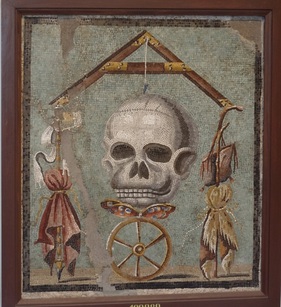

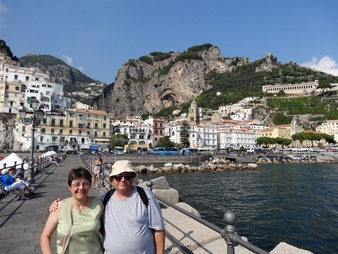
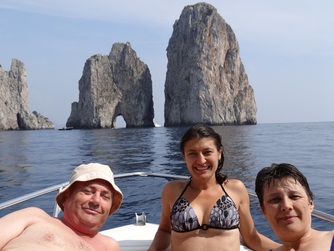
My sister, in her blog Live Love Laugh, wrote about the phrase Carpe Diem from the perspective of a woman who has undergone great tragedy but uses this philosophy as a way to embrace life rather than withdraw from it. As we traveled South of Rome with Neda’s family (they joined us there for a little backpacking family vacation) to Naples and the Amalfi Coast, Carpe Diem became not just a philosophy, but a historical signpost painted over every attraction we visited.  An ominous mural from Pompeii First up was bustling Naples, which with its dirty alleyways connected by interwoven laundry lines was a bit reminiscent of Southeast Asia. The old town’s buildings tower over you as you walk along narrow streets, and the variety of people and noises thrum like the oceans waves. Our main purpose in town was two-fold – eat as much pizza as possible (Naples is the home of pizza!) and visit the Museo Archeologico Nazionale di Napoli, where the treasures of nearby Pompeii and Herculaneum now reside. Both towns were covered under volcanic debris with the explosion of nearby Mount Vesuvius in 79 AD and after being discovered and excavated, stand as some of the best preserved examples of Roman architecture and art available to us today. In the museum, wonderfully vivid murals, sculptures, and paintings have been preserved from the two cities – depicting the mythological, sexual, and everyday art of which the people of Rome adorned their homes and temples. My sister’s philosophy rang through the halls as I imagined the people huddling for shelter while volcanic mud claimed their lives and embedded them into our imagination 2000 years later.  A recent pic of our lady On the pizza front, we ate at “Brandi Pizzeria” the first pizzeria in the world and home of the traditional pizza margherita, which was created in 1889 when the chef of Brandi created a pizza with tomato, mozzarella cheese, and basil for the visit of Queen Margherita di Savoia. Meant to represent the Italian flag with its ingredients, this was the first time cheese was added to this flat bread, transforming it into one of the most popular foods in modern history. Today, the pizza chefs at Brandi are still slinging delicious pies as we found out in person. Though it must be said that for us there is only one Brandy truly in our lives – we miss you little one! It was a thoroughly successful day in Naples, and was followed the next day by a trip to the ancient ruined cities in person where we walked the streets that bustled with life prior to the eruption. Herculaneum is smaller and better preserved than Pompeii, making it a favorite with its ruined bathhouses, villas, and food shops while Pompeii offers a glimpse of the vast destruction caused by Vesuvius.  Nadia and Petko at Amalfi From Pompeii we traveled around the bay of Naples to station ourselves in Sorrento for the exploration of the Amalfi Coast. The coast is named after the maritime empire of the city of Amalfi that once dominated the area. But “Carpe Diem” would linger in our minds when we learned that most of the city, with its population of 70,000 souls, slid into the sea along the steep cliffs of the coastline during an earthquake and ensuring tsunami in 1343. The theme resonated even deeper in our brains as we tottered and swerved along the coastal road on the public bus to get to Positano and Amalfi, only a meter or so away from the steep cliffs that claimed the city hundreds of years before. Today both Positato and Amalfi sit along the coast in defiance of their location, beautiful cities carved upward from the edge of the cliffs into the hills above. We enjoyed perusing the art galleries and letting our eyes water at the prices of food and drink before returning back the way we came on an overcrowded bus trip that afforded beautiful views of the setting sun.  Finally, we headed to the Island of Capri, fabled location of Emperor Tiberius’ summer home and popular jet-setting destination. We rented a “motorized dinghy” to get the real tour of the island and spent four hours gaping at the island’s sheer rock walls lifting out of the sea, snorkeling at the green and white grottos, and sailing through the arched gap in the Faraglione di Mezzo with our little dinghy. As we rounded the island, we could see the fabled Tiberius’ Leap, where legend has it the emperor would have undesired guests and disobedient servants thrown. Near the end of the ride, as we crossed the wake of a giant ferry, we felt like one of Tiberus’ guests and said a final Carpe Diem as the bow of boat lurched upward to the sky before finally settling back safely into the frothy sea. Seeing the precariousness of life over history in the Bay of Naples region beckons one to find appreciation in whatever moments we have on this globe. On this part of the trip we found that appreciation in the time spent with family and the beauty of Italy’s coast. I still hope each day that my sister and her husband continue to find it as they struggle to seize the day in the midst of a tragedy just as world ending as any volcanic eruption or earthquake could ever be.
0 Comments
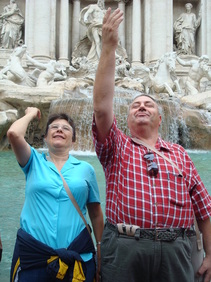 "We'll return to Rome!" On the morning of September 4th, the Bulgarian clan descended upon Rome like Hannibal, with his famed elephants, never could. Petko and Nadia (Neda’s parents) flew in from Bulgaria and Dimitre (Neda’s brother) took the long haul from Boston while we arrived early on the night train from Venice. Our spacious apartment gave us ample space to unwind before beginning a whirlwind tour of Rome’s sites – the Vatican Museum, Sistine Chapel and Saint Peter’s Basilica on one day, the Pantheon, Spanish Steps, Trevi Fountain, and Piazza Navona another, and the ancient Rome of Palatine Hill, the Forum, and the Coliseum on the last day. It was the first time this part of our family had ever visited Western Europe and the first time in our trip of the world that we have been joined by family. Italy is a great place for such a meeting, as the wonderful cuisine and multi-course meals provide time to catch up and enjoy the company. I’ll skip description of the common tourist attractions above because there is already so much information about them available online or in books (though I will pepper in some pictures of them below). But one slightly lesser known attraction turned out to be my favorite and was tremendously fitting to visit with a family of Bulgarians! 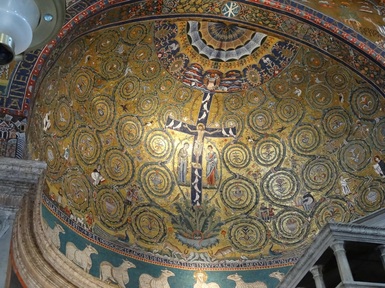 The Tree of Life San Clemente Church sits about a half of a kilometer from the Coliseum and at first glance, it appears to be another beautiful 12-13th century building in Rome. Its central nave features a golden fresco of Christ connected to a “Tree of Life”, a winding network of vines that demonstrates the interconnectedness of life. This is the first clue that this church is a bit different from others, as such an explicitly eastern theme rarely occurs in the churches we've seen so far. But the real beauty and intrigue of San Clemente lies beneath it. It is here that a 4th century church has been preserved in the catacombs of the newer church. This original San Clemente church is haunting to walk through as its LCD lit rooms provide just enough light to imagine worshipers here over 1500 years ago. 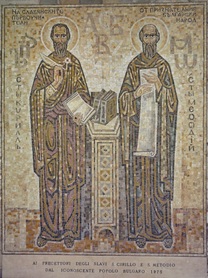 Cyril and Methodius For us the main attraction lay in one of the side naves of this ancient building. It is here that Saint Cyril is buried. Cyril, along with his brother Methodius, created the foundation of the Bulgarian written language, called Glagolitic. Cyril had been in Rome to argue that the church liturgy should be spoken in Glagolitic so that the natives of the Slavic regions could understand it. This was opposed by the German clergy, who had used Latin in the region to maintain their position. Cyril convinced the pope that Glagolitic should be allowed, but died shortly after. The Pope wouldn’t let him be returned to his home so his brother asked that he be buried at San Clemente church (whose body the brothers had returned to the Vatican just a year earlier from the Black Sea). Cyril’s tomb was surrounded by tablets inscribed with messages from the nations and peoples he had influenced. There were tablets from the Serbians, Ukrainians, Russians, Slovenians, & Croatians. The Bulgarians had sent a beautiful mosaic of the two Saints to sit opposite the tomb, in honor of the language that Cyril and his brother had given written form. Bulgarians hold a special regard for the Cyrillic alphabet, as it was fully refined from the Glagolitic alphabet Cyril and Methodus had created by their students under the sponsorship of Kings Boris and Simeon during the 1st Bulgarian Empire. It was touching to see all the nations that had honored this man who had helped create a common written bond between them. Much like the Christ depicted in the church above, Cyril’s tomb was a testament to interconnection. 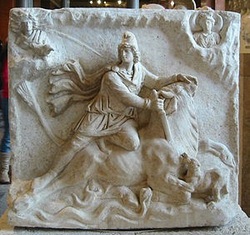 Mithras slaying the bull For most visitors to San Clemente, the interesting part of the visit is not just the 2nd church that lies beneath, but the even older archeological area beneath the 2nd church! It is here that archaeologists have discovered the best preserved “mithraea” (underground temple of the religion of Mithraism) in the world. Very popular among Roman soldiers between the 1st and 4th centuries, the Mysteries of Mithras revolved around the story of the God Mithras slaying a wild bull for the God of the Sun. As the bull dies, its blood gives life to the ground around it. Initiates would eat bread and water to represent the body and blood of the bull and the life it gives out of its death. Citied as an early competitor with Christianity, Mithraism shared many of the same rituals before being systematically destroyed by the early Christian Church. That is why many mithraea have been found with Church’s built on top – a symbolic representation of Christian domination over its competitor. With ancient religions lying beneath the foundations of the Bulgarian ancestral language, Rome proved to be a penetrating historical experience for all of us. From there, we would head down to an equally interesting region of Italy – the Bay of Naples, where ruined cities and the ghosts of the past waited.
To see all the pics of Rome, some of which were taken on Jeff's new Sony Cyber-shot DSC-HX30V camera, which includes GPS tracking of our shots, click here! 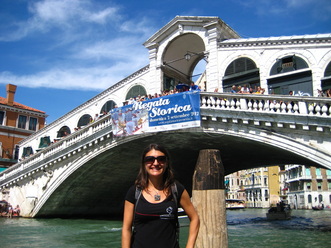 The Rialto over the Grand Canal With Slovenia and Croatia so heavily influenced by the power of the Venetian Maritime Empire of the middle ages, we felt it a natural next stop as we headed into Italy. Venice was bustling during our weekend there with two big events occurring – the Regatta Storica and the Venice Film Festival. Our first night in town we marveled at the city’s interwoven web of bridges connecting the 170 islands that make up Venice proper. Crossing from island to island so seamlessly over intricately carved arched bridges is a reminder of the architectural genius that was required to turn this swampy marshland into one of the most powerful and beautiful cities in history. As we wandered along, we serendipitously came across Piazza San Campo, where we saw a line of people waiting for tickets to a showing of the film festival. Our timing was perfect and we snagged two tickets to “At Any Price” starring Zach Efron, Dennis Quaid, and Heather Grahm (we missed the premier the stars attended by only a day!). After enjoying a quick bite of our first “pasta fresca” (homemade fresh pasta, which in comparison to typical package pasta in America is wonderfully firm and flavorful), we headed to the movie, which was showing on a giant screen right in the middle of the piazza. The film is a compelling drama revolving around the plight of the small American farmer as he sacrifices his values to an “expand or die” mentality and becomes increasily boxed in by the ominous reach of Monsanto’s GMO seeds. These genetically modified seeds are patented by Monsanto and require farmers to buy entirely new seeds each year rather than clean and re-plant the seeds as they have been doing for centuries. The movie also features heavy doses of American iconography, with Nascar, the National Anthem, and loads of shots of Iowa cornfields. The result was that I ended up feeling closer to America than I had since leaving over a year ago. What a strange feeling to have while sitting in the middle of a 500 year old piazza in Venice! 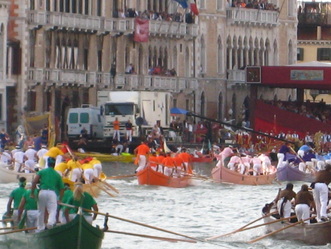 The Regatta Storica The rest of our time in the city involved lots of walking as we explored the city’s circuitous routes. We caught a bit of the Regatta Storica on the main canal as thousands of Venetians donned traditional garb and raced their boats and gondolas along the canal in a tradition harkening back to Venice’s days of maritime glory. We gaped at the amazing Piazza San Marco where the enormous bell tower occludes the sky and the gorgeous church gleams golden in the sun. We also struggled a bit to find good restaurants in this town whose daily count of tourists outnumbers residents! With copious copertos (a charge for sitting down which seems to get you nothing but some stale bread) we bounced like ping pong balls through the streets looking for a decent place to eat. By the end, we were ready to hop on our nighttrain and get down to Rome to meet the family, but we were happy to have gotten to experience some charm and Romance in Venice.
Dreams have always intrigued me and leave me wondering if they have a deeper meaning. Does the brain weave nets of subconscious thoughts that can only be unraveled in the middle of the night? I remember my dreams often, more often than most people I know. And in nearly all the dreams I remember I am running. Running from something, from anything. Sometimes, I am running from aliens or from Roman soldiers, through woods or between canyon walls. Usually, the colors are so vivid and the dreams so engrossing, that I awake panting and looking around - only to find my bedroom and Jeff sleeping peacefully at my side. 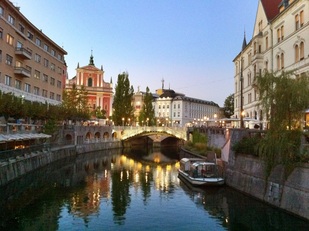 Beautiful three bridges in Ljubljana But something changed in Slovenia! For the first time in my life, a different kind of dream was revealed to me. In this plot, I was a detective and was determined to catch a serial killer. Finally, the tables were turned and instead of running away from a killer, I was running after one to stop another murder from happening. This feeling of empowerment in the dream caused a rush of relief to wash over me as I awoke that morning. I felt like the dream was a prophesying a time when I would have the opportunity to turn the tables on my fear. Or was the dream simply an affirmation of the many fears I have already shed during this travel time? 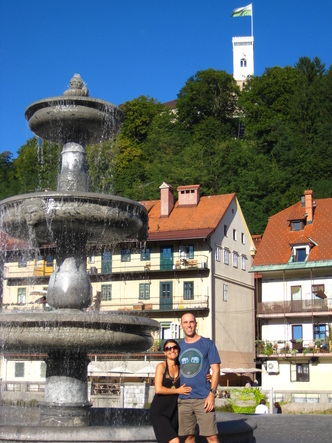 The central plaza with the castle in the background Slovenia, much of which is nestled in the Julian Alps, brought some of the most beautiful mountain scenery we have encountered thus far. We started in the capital city of Ljubljana, a lovely town towered over by its beautifully restored castle. Ljubljana is one of the smallest capitals in Europe and doesn’t have any major ‘attractions,’ which makes it great for strolling the streets while scoping out gelaterias and sweet shops. The charm of the city is largely attributed to Jože Plečnik, who largely rebuilt the city’s waterfront and key civic buildings after an earthquake in 1895 left the city an open palette. His playful and seducing architectural buildings and bridges give the city a feel of enchantment that is augmented by the stunning views we enjoyed from the castle. For pictures from Ljubljiana, click here - http://flic.kr/s/aHsjBT2hNS. After some time in the city, we were ready for nature and moved on to Lake Bled, our base for exploring the Julian Alps. Lake Bled may be one of the cutest little towns in Europe! The homes looked so idyllic they could have come straight from a movie and they all surround this gorgeous glacial lake that was formed when the Bohinj Glacier melted after the last Ice Age. Even more romantically beautiful, the receding glacial waters left a tiny little island in the middle of the lake. It now holds the Church of the Assumption, a 17th century baroque church, though excavations have found remains of a Slavic cemetery and a pre-Romanesque chapel. The island was considered a place of great importance to the local Slavic tribes who lived here before Christianity. They so fiercely defended this little island that the Romans could never overtake the area, despite it being right next door to modern day Italy! With the Julian Alps as the backdrop to this picturesque lake and its little island, the view from the Mala Osojnica viewpoint (which we climbed at a breakneck pace to beat the sunset) was breathtaking! 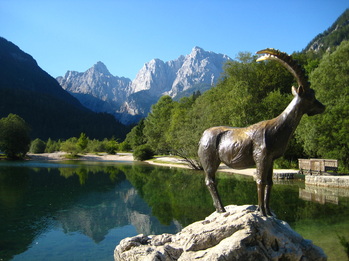 The Goldhorn at the entrance to Triglav Our second day was a small tour full of adventures all throughout the park, which takes up about a third of the country. The jagged ridges of the mountains are dramatic against the blue sky, and always look like they are covered in snow due to the crumbling rock atop. The symbol of the locals is the Goldhorn, a type of buck, who is highly respected in this area. It lives at the highest peaks of these mountains and the end of its horns really shine as if they were gold. Ancient myth says that at one point Triglav park was a paradise of greenery and soft hills where humans and magical creatures lived in harmony. Ruling over it all was an immortal white Goldhorn. During this time, three mountain ferries known for their fortune telling abilities had a vision after a local boy was born in the mountains. The fairies saw that the boy would one day kill the Goldhorn for his gold and ruin the paradise they all enjoyed. Two of the fairies refused to speak of the vision, but the third fairy voiced this prophecy and was cursed by her two sisters for doing so. She was turned to stone by the curse and it is said that you can still see her petrified face edged in the mountain stone. 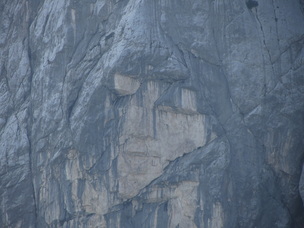 The Petrified Fairy, Julian Alps In the end, the prophesized boy grew up and fell in love with a beautiful Slovenian girl who had also caught the eye of wealthy Venetian merchant. The merchant showered her with expensive gifts that the pour hunter boy could never match. So he decided that only by killing the Goldhorn and collecting his golden horns could he compete with the merchant and win over her love. After an epic three day chase, they met on a ridge where both man and beast stood facing each other. The boy shot at the Goldhorn and his aim was true. The arrow pierced the beasts neck and blood started to gush onto the ground. But to the boys surprise, where the blood hit the ground, beautiful white alpine roses immediately sprung up and blossomed. The Goldhorn ate the flowers and his wound immediately sealed up and healed. In a rage now, the Goldhorn charged the boy, who tried another arrow but missed as he was blinded by the reflection of the oncoming horns. He took the charge straight on and tumbled down the hills to his death. The prophecy was broken. But so was the Goldhorn’s faith in humanity. The immortal beast was made with rage and disappointment as he ran across the planes, thrashing them into the jutting mountain peaks we see today. Nobody has seen the Goldhorn ever since, but locals say the tale cautions us to respect both the power of nature and also its fragility to human greed. 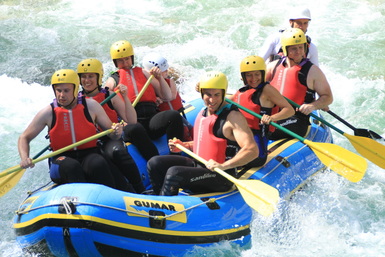 Rafting the soca The next part of our tour took us on a rafting adventure down the Soca River, or Emerald River, as the locals call it. The river is bright turquoise green and its crystal clear water is full of the rare species of trout, called marble, who can grow to be over a meter long! It is mesmerizing to look into the water and chilling when you jump in! Though the river was relatively low due to the drought this summer, the guides still made the trip lots of fun by setting up water slides with the rafts and offering us some optional challenges. Here is where my own dream (or prophecy?) comes into play. One of the stops of the trip was a huge, 8 meter (due to the low level of the river) high rock, edged into a deep pool of emerald water. The guide warned us that the jump looks much higher once you’re up there and that there is no easy turning once you go up. I hesitated for a moment as no other girls even attempted to climb the rock. But then I thought of my dream and scaled the stone. First up, Jeff jumped into the water with little hesitation, though he admitted that it was quite scary for him too! As the 2nd to go, when I reached the ledge of the rock, I found myself frozen in fear, especially since one of my biggest fears is of heights! We have climbed many waterfalls, mountain tops, and tall buildings through these travels, and with each journey I can feel a little bit of my fear melting away. But I have to say, jumping 8 meters into a foreboding flowing river is a whole another different story! After much coercing by the guide and encouragement from the crowd, I finally gathered the courage and jumped. Unfortunately, there was a photographer documenting our whole river trip (pics here) and he caught a really good picture of me on the way down. I didn’t know that my face could contort to this position! In this land of prophecies I was happy that my own came true. As in my dreams, I had overcome my fears and become the hero of my story instead of the victim. We finished our time in Bled by renting a row boat and visiting the little island. Rain forced us to act quickly and Jeff to row like a madman to get back to the mainland. We took this opportunity to relax and enjoy an afternoon in our little apartment as we prepare to cross into Italy with a stop in Venice en route to Rome to meet my family! For pics from Triglav and Bled, click here - http://flic.kr/s/aHsjBSZJ1s.
Croatia is a country still trying to find itself after 46 years of communist rule followed by a brutal war where Croatia fought against Serbia and the former Yugoslavia army for its very existence. It was only in 1995 that it established its independence and found a semblance of stability. Now, 17 years later, Croatia is on the cusp of EU membership and its economy is held afloat by the massive amount of tourists that visits its nearly 6,000 kilometers of beautiful coastline. 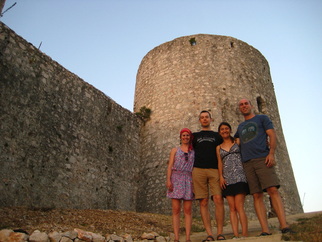 Amy, Tom, Neda, and Jeff at the Crikvenica fortress Tom introduced us to some classic Croatian dishes like black cuttlefish risotto and the home made “surlice” noodle served with white wine, cream, and fresh seafood. Croatia was under Venetian rule for nearly 700 years and so Italian influences intertwine with the typical Slavic kitchen in delightful ways. The fresh seafood and pasta were highlights of our time there. While in Crikvenica, we also got to meet Tom’s parents and enjoy some delicious meals with them. Tom & Amy took us on a day trip to the island of Krk where we swam in deliriously clear turquoise water and sampled white wines made from the delicious local Zhlatina grape. Perhaps the most fun came as we were riding along the road and spotting bountiful fig trees, heavy with unpicked fruit. Tom would pull off to the side of the road and we would all run out to collect as much booty as possible. A few extra plastic bags that Neda brought were soon stuffed with ripe figs. We ate so many that our tongues went slightly numb, but it didn’t stop us from feasting on surlice while enjoying beautiful views of the Croatian mainlaind across the sea. Thanks for your hospitality, Golubs! See all of our pics of our time with Tom and Amy here: http://flic.kr/s/aHsjBC1StJ. 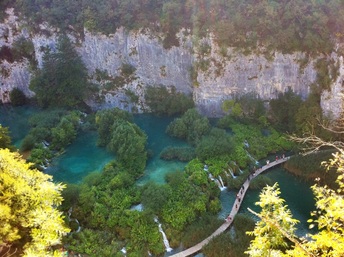 Plitvice lakes from above We parted with Tom & Amy for the only part of our trip that took us inland – Plitvice National Park. Plitvice is formed from several lakes connected by underground rivers and limestone karsts. The movement of the calcium rich travertine around the lakes has formed numerous waterfalls and cataracts, which when combined with the gorgeous hue of the lakes water, makes for a magical experience. The entire lake complex is lined with wooden walkways that traverse the swampy parts of the lake and allow you to get some amazing views of the falls. With only a few hours to see the park before trying to catch an onward bus, however, Neda and I found ourselves dodging past tourist after tourist on the walkways as we took in as much of the park as we could. See all the pics of Plitvice here: http://flic.kr/s/aHsjBD1Fhs. Bus service from Plitvice is pretty limited and after missing the bus to Zadar, we had only one other possible bus we could catch to the rarely visited city of Knin, known mostly for its cliffside fortress and for being the stronghold of the Serbian push to takeover Croatia. We tried hitchhiking to get to a better destination down south, but were met only by zooming cars for over a half hour. Finally, the bus to Knin pulled up, and lacking any other options, we got on! It was one of our more adventurous days in Croatia because as we talked to some locals on the bus to Knin we found out that accommodation was pretty scarce in town. Eventually, a Croatian woman from the bus talked to a local at the station who was kind enough to drive us to the only hotel in town – a shabby little place that still charged us $50 for the night because it was “high season”. That was just the beginning of our realization that Croatia was going to be one of the most expensive places we’ve visited over the whole of our travels. The exhausting day at Plitvice was going to be followed by another national park full of waterfalls, but at the last moment at the Knin bus stop we changed our minds and ran over to a train headed for Split. Without a car, the logistics of seeing Krka National Park was nightmarish and we’d just had enough. It turned out to be the right decision. 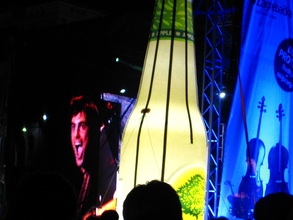 Crazy celoist rocking out We arrived in Split and a local woman waiting at the station convinced us to check out an apartment she had just outside the center. The place was wonderful at the right price so we spent 3 nights in Split, enjoying all the city had to offer. On the first night, two famous Croatia celloist played pop-rock songs on the waterfront – a spectacle that couldn’t help but make Neda and me laugh at some points. Check out their rendition of smells like teen spirit: http://youtu.be/XqkbN0I_Iac. 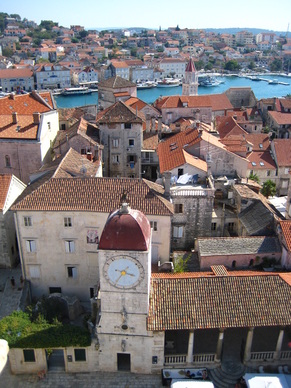 View of Trogir from bellfry Split was the site of the retirement palace of the Roman Emperor Diocletian at the turn of the 4th century. Diocletian http://en.wikipedia.org/wiki/Diocletian was a fascinating emperor, coming from a Croatian slave family before rising up to the rank of Emperor through military and political cunning. He bears the distinction of being the first emperor to think up the idea of retirement (I like this guy already!) and one of the few to die of natural causes. His retirement palace was a massive structure that would alter the course of Split’s history. About 300 years after his death, as the Roman empire fell, the citizens of Diocletian’s native Salona fled to the now ruined palace as a place of refuge. There they set up shops and homes in the halls and towers of the palace – slowly modifying it into what would become the center of the city of Split. To this day, the palace still occupies the center of the city, and Neda & I had a wonderful time exploring its ruins. We climbed the bell tower (built later next to Diocletian’s mausoleum) for sweeping views over the palace and city and also climbed a hill outside the city, where we would have enjoyed a beer as the sun set on Split if we’d have remembered to bring some cash! We also took a day trip to Trogir, a well preserved medieval town just north of Split. See all of our pics of Split and Trogir here: http://flic.kr/s/aHsjBDgBfQ. From Split we took a ferry to ancient town of Stari Grad on the island of Hvar. Stari Grad is the oldest recorded town in Croatia, though for us it was all about sipping white wine at cafés, enjoying the town’s splendid rock beaches, and catching a showing of the local film “Lavender Man”. Full of inside jokes about the island and horribly drab dialogue between the superhero Lavendar Man and an investigating reporter, I fell asleep on the film pretty rapidly, despite my attempts at revival with a Jack and Coke! Hvar Town on the other side of the island features some interesting architecture, as the Spanjola Fortress rises behind the city’s cathedrals and palaces. After a day stop here, we were off to Korcula, our next island. 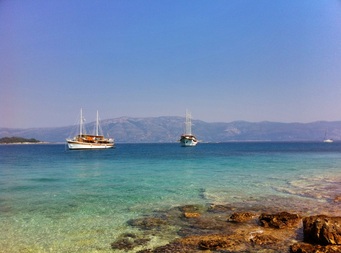 The beautiful Lumbarda Beach!! Korcula Town is a beautifully symmetric bit of land that juts out into sea in the shape of a leaf. The town is laid out like the veins of the leaf, with a main street running down the middle and side streets branching off from there. This keeps much of the old town in shade during the hot summer days. Korcula is also the first town on record to outlaw slavery in 1214. The town is very very small and so suffers a bit from tourist overload, but a short bus ride to Lumbarda brought beautiful beaches, delicious local white wines (yet again), and one of our favorite meals – the Lumbardian platter in a restaurant based in an abandoned boathouse on the beach. Island food in Croatia revolves several dishes, which we often enjoyed. There is the Octopus Salad, which when prepared with oil, citrus juices, red onions, and capers becomes a cacophony of flavors on the palate. We also savored the salted and marinated anchovies, the sheep cheese from the island of Pag, and the delicious prosciutto (though the prosciutto didn’t quite compare to our trip in Italy!). See all the pics of Hvar and Korcula here: http://flic.kr/s/aHsjBHbhCs. 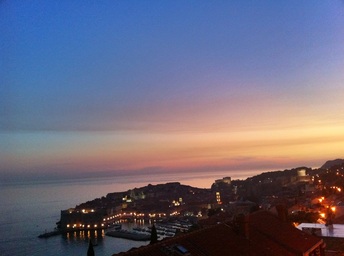 Mesmerizing view of Dubrovnik from our balcony Finally, our trip in Croatia ended all the way on the southern tip with the stunning city of Dubrovnik. Dubrovnik holds special significance for Croatians because during medieval times the city and its small republic (called Ragusa) managed to stay mostly independent in its governance. It was one of the most important port cities in all of Europe and its connections and trading posts in what is today Eastern Europe allowed it to turn fat profits as it resold goods to its Western neighbors. The result of this wealth, as well as an earthquake in 1667 that leveled most of the city, is an orderly Baroque city with towering city walls, smooth marbled streets, and a variety of lovely palaces, cathedrals, and fortresses. Neda and I got a lot of exercise while staying in Dubrovnik, staying in a hotel up the hill outside of the old city. Our location was rewarded with stunning views of the city and a 900 step walk down to the beach! While in Dubronik, we stayed healthy by eating at the wonderful salad bar at Nishta and stayed naughty with cigars and wine outside of Orlando’s fountain while listening to jazz. Dubrovnik is best avoided during the peak of the day, when visiting cruise ships turn it into a sardine can, but in the early morning and in the evenings the town settles back into lucidity and can be enjoyed in all of its stunning beauty. Our intended trip to the island of Mljet was also deep sixed when we arrived at the ferry an hour early, only to miss the last tickets by about 10 people. So, a day trip to the beautiful Tristeno gardens in lieu of Mljet soothed us with its beautiful Neptune fountain. Finally, we flew up to Zagreb, where we had a few hours to explore the city before heading off to Slovenia. See all of our pics of Dubrovnik, Tristeno, and Zagreb here: http://flic.kr/s/aHsjBQjkiq. All in all, Croatia was a beautiful country and a great place to meet up with our friends. But as it relied on tourism as its number one trade, authentic experiences were a bit more difficult to find along the coast, causing Neda and me to feel like we were really on typical recreational vacation more so than in most other places. This is a good thing in some ways, but not so good for our wallets, which were burning up as we passed through the tourism tunnel that is the Croatian coast. We were glad to leave the beach and the beauty behind and head for less crowded territory in the tiny country of Slovenia…
The next stop on our journey was an extended layover to Budapest, taken as the most expedient way to meet our friends Tom & Amy down in Croatia. As we took a walking tour of the city, we admired the Hapsburg era architecture on Castle Hill and along the Danube River separating Buda from Pest. Budapest is full of beautiful buildings – from the Parliament building to the Opera House. They also have the oldest underground in Continental Europe (2nd in age only to London in the world), built during the glory days of the late 19th century when the country was celebrating its millennial anniversary. 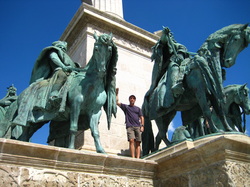 A tribute to the Magyar tribes The anniversary marks the year the 7 horse riding Magyar (Hungarian) tribes arrived in the Carpathian Basin that is present day Hungary in 896. Neda and I saw some parallels with Bulgaria here, as the Bulgars who rode into early Bulgaria were an Asiatic horse riding people as well. The Bulgars were a minority compared to the Slavs of the region (the Slavs allowed them to govern due to their ability to protect the population from the Ottoman Empire) and eventually many of their customs were assimilated with Slavic ones. In the case of Hungary, assimilation came as a result of the Mongol Horde that attacked the country in the 13th century, decimating an unbelievable half of the population. When the Mongols were finally forced out, the Hungarian crown had to repopulate their country with the peoples of surrounding areas – thus the reasons Hungarians do not appear Asian in origin. 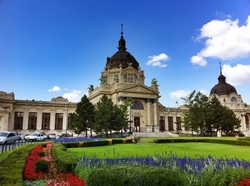 The Szechenyi Baths Though the Mongols were a devastating time in history for Hungary, its successive invaders would prove to be much more gracious than Bulgaria enjoyed. The inevitable invasion by the Ottoman Empire lasted only 150 years in Hungary as compared to 500 in Bulgaria. The Turks didn’t destroy the churches in the city of Budapest, but instead repurposed them as Mosques. They also left behind the culinary legacy of Hungarian Paprika and the vibrant tradition of the Turkish Baths, which built upon the fact that Buda is a hotspot of natural mineral springs along the Danube. The Turks were forced out of Hungary by the conquering Habsburg Empire in 1686. But the mid 19th century, however, Hungary had managed to establish a dual monarchy that made Budapest a 2nd capital of the empire alongside Vienna. This stability led to unprecedented growth during which time such architectural marvels as the Parliament Building and underground line were constructed. All this is not to say that Hungary has had an easy history. But its beginnings have an interesting similarity to those of Bulgaria that diverge due to Bulgaria’s proximity to Turkey and its distance from Western Europe. There was no Habsburg empire to bail Bulgaria out of 500 years of oppression by the Ottoman Empire and no relief from the 50 year reign of censorship that Communism brought. The result left us wondering how Bulgaria might have looked if it had been located further north on the continent. Would it have retained more of its architecture, most of which now is just communist style concrete slop? Of course such questions are pointless as Bulgaria’s very identity is irreparably entangled with its invaders. But then again so is Hungary’s, only their invaders left behind a bit of beauty with their destruction. 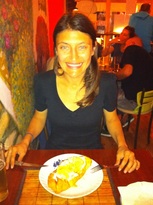 Our pitstop in the city was lucky enough to coincide with the Sziget festival – a week long mega festival on an island in the middle of the Danube that brings in huge acts from around the world. We danced the night away with LMFAO, Beardyman, and the Killers. With over 300,000 people in attendance the event could only be described as one hot mess. But fun for a day! Lots of partying and too many langosh’s (a Hungarian specialty comprising of a circular piece of fried dough topped with garlic, cheese, and sour cream - Neda had one with chicken paprika on it pictured here) made our stomachs ready to leave Hungary as we headed down to Crikvenica) to meet up with Tom & Amy!
“Why leave behind the seat in your own home to wander in vain through the dusty realms of other lands? If you make one misstep, you stumble past what is directly in front of you.” The above quote from Dogen’s Fukanzazengi so accurately depicts my feelings as we traveled through Bulgaria with our friends Brett and Christie. Dogen, of course, is referring to the fact that the wonder of the present moment is available to us no matter where we are and that it can be folly to think that happiness lies in traveling to new lands. Yet we recognize that travel is a wonderful way to challenge engrained habits and finding living ways to connect to the present. Still, Dogen’s words echoed through my head as we returned to Bulgaria to show its beauty to our friends. We visited some sites we have seen before and some that we haven’t, but each site brought more wonder and awe than most we have seen around the world. My appreciation of the wonders of my home grows with each step I take through it. 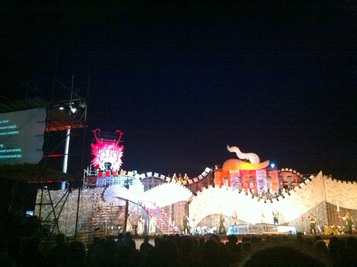 Turandot at the ruins Our first stop was Veliko Tarnovo, the old capital of the Second Bulgarian Empire. We have been there many times before, but through travelers' eyes the city and its ruins appeared even more beautiful and majestic than before. As we waited for our friends’ bus to arrive, we happened to stumble upon a free opera presentation of Turandot right in the heart of the ruins of the old city of Tzarevetz. The ringing voice of the singer portraying Prince Altoum was mesmerizing as it carried through the ruins of the ancient city, bringing a life to the place that has been absent for centuries. This was one of the top experiences of our travels! 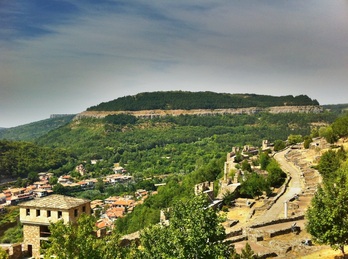 Views of Tzarevetz from the tower We explored the new city of Veliko Tarnovo and the old ruins with Brett and Christie the next day as we began to introduce them to traditional Bulgarian foods and drinks. As vegetarians, they were thankful to discover the fresh vegetable salads that crowd the menus here. They also loved Bulgarian tarator, a cold summer soup of yogurt, cucumbers, garlic, dill, and walnuts. We took a short trip up one of the hills to visit the small village of Arbanasi, where many 18th century homes have been preserved and some serve as museums. To see pictures of this leg of the trip, click here. Our next stop was Stara Zagora, where I have spent the majority of my life. My mom prepared delicious vegetarian versions of Bulgarian dishes and we shared our gardens’ veggies and fruits with our guests. We took them to see the famous Shipka Monument, dedicated to those who died in the Liberation of Bulgaria at Shipka pass. Shipka is sort of like the Bulgarian “300”, where 7,500 Bulgarian and Russian soldiers defended the pass against nearly 40,000 Turkish soldiers during a grueling winter campaign. The views from the top uncovered rolling hills of limitless mountains and peaks. (Pics for Shipka here). We could also see Buzludja perched atop its mountain, our next stop of the roadtrip. This ruined Communist monument was fascinating and deserved its own blog post; you can read about it in our previous post. Of course any trip to Stara Zagora with the Fields’ isn’t complete without the mandatory tour of the Zagorka brewery and the ensuring hilarity. Even though the brewery was bought by Heineken back in the 90s, it is still the area’s beloved local beer, and the brewery remains the only place you can taste their fresh 6.4% probiotic packed live beer at the end of the tour. As sometimes happens with Bulgarian hospitality, the 30 min tasting session turned into 1.5 hours and many smiles as it did when our friend Ryan came to visit last November. Check out the rest of the pics here. With dad driving our caravan, we set off to the south western part of the country where the smallest town in Bulgaria lies - Melnik. Most of the town’s buildings are preserved cultural monuments indicative of the life of the people here a couple of hundred years back. 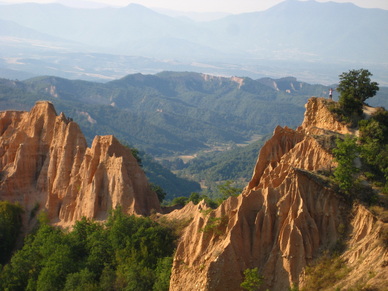 The beautiful sand formations According to archeological evidence, the Thracian tribe Medi first settled this area and interestingly enough, Spartacus belongs to this tribe! The city is surrounded by unusual and unique sand formations called the Sand Pyramids. As we hiked up the pyramids in the early morning, we were awed by the glowing rocks and delighted by the panoramic views of this part of the country. We ended our hike at the Rozhen Monastery, the biggest monastery in the Pirin Mountains. Melnik also offered a variety of wonderful foods, including the tasty Greek fish Tzipura (Sea Bream) and unique wines from the region. Christie arranged for us to visit a winery, Villa Melnik, which turned into an afternoon of hospitality and generosity by the owner, Nikola and his vintner Didier Mailhe. While his new larger wine making facility was not fully completed yet, Nikola still graciously took us on a tour of the building and showed us every detail of how the wine will be produced here. He also took us out in the vineyard, where he plucked handfuls of different varietals and let us try them all! He then invited us into his home, but not before taking us to visit a local rakia distillery, where Brett & Christy could see this authentic Bulgarian spirit being made under the hot Melnik sun! Back at Nikola’s home, Didier led the tasting as bottle after bottle of Villa Melnik’s best were uncorked. Each bottle was more delicious than the next and most had won medals at the International Winery Exhibition in Plovdiv. One of our favorites was the spicy and bold Melnik 55, a red made with the local grape of the region. Thank you Villa Melnik for such a memorable experience!! Pics from Melnik are here. En route to our next destination, we stopped to see the famous Baba Vanga monastery, where we chillaxed, slacklined, and enjoyed the peaceful space she had created. We also took a hike in the Pirin mountains and visited its largest waterfall. Pics of this day trip are here. 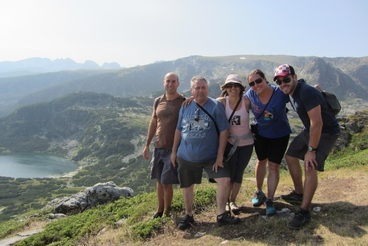 The crew with fish lake in the background Our next big adventure lay in the Rila Mountains, home to the infamous Seven Rila Lakes. We took a lift up to these high altitude lakes, which were formed by melting glaciers many years ago. Each lake is named after its main characteristic such as the Tear for its clear waters, the Eye and Kidney for their shape, the Twin, the Trefoil, the Fish, and the Lower lake in order of their location and height. Even from the lift it is another 3 hour hike up to the highest peak, which rewarded us with an inspiring view of the Rila Mountains surrounding these mystical lakes. The crystal clear waters of the lakes serenely reflect the surrounding peaks and imbue peace to the observer. Some believe they represent the Seven Chakras from the yogic traditions and it is easy to understand why as the 7 lakes are all connected by the “spine” of flowing waterfalls. There is even a religious sect called the Dunovisti, that spend the whole month of August performing ecstatic dancing in a series of concentric circles close to the lakes as they commune with God and nature. This amazing natural phenomenon is one of the most beautiful we have seen from anywhere in the world. I couldn’t help but smile as I recalled Dogen and wonders that lie “in the seat” of my own home. See all the beautiful shots of the Rila Lakes here. For our last evening, we arranged to spend the night at the Rila Monastery, one of the most visited and beautiful monasteries in Bulgaria. We enjoyed our bottles of Villa Melnik wine and fresh trout from the Rila River for our last dinner with Brett and Christie. As the peaceful chatter of the river put us to sleep I heard one of my favorite ATB songs in my mind and realized that I couldn’t have dreamed a better trip through my homeland. I feel the crunch of glass beneath my feet. The echoes of voices wafting from the central chamber. The crumbling murals now decorate the floors as much as the walls. The air harkens back to a time of pride and memory but is singed with the heat of anger. 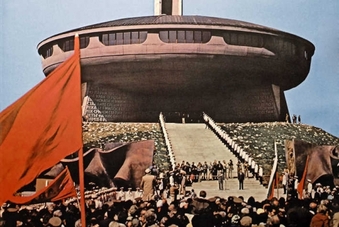 Buzludja in glory days I am walking through the former House-Monument of the Bulgarian Communist Party, named now simply for the mountain upon which it perches - Buzludja. The construction for the monument was finished in 1981 as a 90 year commemoration to the meeting in 1891, where socialist revolutionaries met atop Buzludja to form the foundations of what would later become the Bulgarian Communist Party. But just as meaningfully, the monument was also meant to mark the 1300th anniversary of the foundation of the first Bulgarian Empire in 681 AD. At the time, the site cost a whopping 16 million levs to build (the equivalent of about $10 million dollars in 1980), much of it through “suggested” donations from the Bulgarian people. It took 6,000 workers 7 years to build, and involved 20 leading Bulgarian artists who worked for 18 months on the interior decoration. But after only 8 years as a functional monument, the end of communism in Bulgaria saw Buzludja turned over to the new state, where it was left to ruin by the elements and looters. In 2011, the monument was turned over to the Bulgarian Socialist Party, who promptly welded shut all the entrances, declaring it dangerous and unsafe to enter (which it is). We visited Buzludja as part of a tour of Bulgaria for our friends Brett & Christy, who we met in Thailand. When you first arrive, you can’t help but be stunned by the site of the UFO-like monument perched above the mountain. Its remote location made it an architectural and engineering feat for any time period. Bulgarians tell stories about how at first prisoners were made to work on the monument, then the military joined in, and eventually many volunteers were inspired to help. Abutting the main spherical chamber is a massive concrete tower with a 45 meter high red star embedded in the side. The star is 3x larger than the one at the Kremlin. It is said that when Buzludja was still operating and the star was lit, you could see it from many miles away…though all the electricity of constantly heating the building and lighting the star would often leave local villages in the dark. The star was also rumored to be made of real rubies…a rumor proven untrue when after the fall of communism some people shot machine guns at the stars and received only ruby colored glass in return. 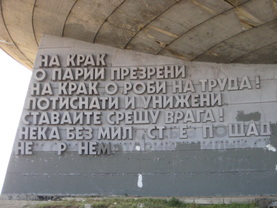 On your feet you slaves of labor... On the street and next to the walking path leading up Buzludja, are two enormous sculpted hands holding torches, keeping guard over the monument. After you take the steep climb up the hill to the monument, you reach the square at the entrance to the building where the party would have held gatherings. Written in giant Cyrillic letters on either side of the doorway are the lyrics to the International Communist Hymn that was sung by communists of all nations during the time of Soviet rule. That would have been it for our visit, but we were lucky enough to run into an intrepid individual who runs tours through Buzludja for visitors. He found an underground entrance near the building where, with the aid of a rope, one can repel down into the ruins. Despite our reservations, we were yearning to see this chapter of Bulgaria’s past, so we grabbed hold and followed them into the darkness…. 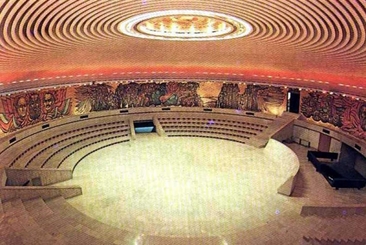 ...and then. Moving through dark corridors…the musky scent of dust and degradation. Climbing the steps towards the light and arriving to a scene of…utter grandeur. Despite the looting and elements, the central chamber of Buzludja is still an awe-inspiring one. The huge spherical chamber is covered in communist styled murals, culminating in a huge hammer and sickle at the ceiling surrounded by a call for the Proletariat in every country to unite. Little remains of the floor, which is said to have been pure marble, or the roof of the sphere, which is said to have consisted of over 30 tons of copper. But many of the murals, in varying states of decay, remain. Of particular note is the mural one sees just upon entering the main chamber. In the center is the face of Dimitar Blagoev, known as the founder of Bulgarian socialism. To his right is Georgi Dimitrov, an early Communitist politician who led Bulgaria from 1946 to 1949. But most interesting is the shadow of the image to the left. Here, the tiles of the face of Todor Zhivkov have been carefully removed, leaving only the outline of his visage. Zhivkov was the President for nearly the whole tenure of communism in Bulgaria – from 1954 to 1989. His missing face is a mystery – either removed by angry protestors after the fall or removed by the man himself when he no longer wanted to be connected to a fallen regime. 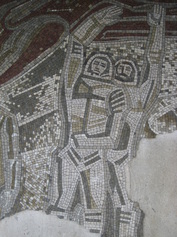 The astronauts The murals are more than just communist leaders. Walking around the outer chamber with its Enterprise-like windows offering sweeping views of the surrounding area, there are celebrations of the Soviet astronauts who first entered space. There are murals commemorating the workers who built the monument. There is even a mural of a Slavic God (perhaps Pirin or Stopan) standing in the middle of the field as the Russian Army liberates (or invades based on your perspective) Bulgaria. Sadly, that last mural was in such a state of decay that it was barely recognizable – this picture from the old times shows what it once resembled. 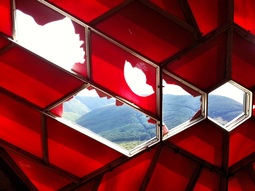 A view through the star As we left the central chamber, we climbed the 10 stories of ladders in the dark to reach the top of the tower where the grand red star lies, still shattered from the gun fire of 20 years ago. The red light shining through the glass casts an eerie glow on the rusty equipment lying around. Sitting anachronistically on one floor was a modern spotlight, probably used by the Socialist party recently in commemoration of their founding. Finally, we emerged at the top of the tower where the stunning view of the countryside, the remains of the roof of Buzludja, and the hillside monument of Shipka takes one’s breath away. 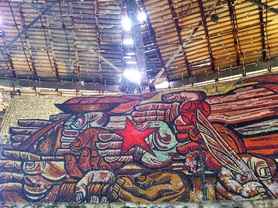 The state of Buzludja left Neda and me with mixed feelings. The site of this great architectural wonder of Bulgarian history being left to ruin filled us with sadness. As we moved through the abandoned halls, it brought to mind the lineage of teachers we are connected to in the Zen tradition. The lineage moves through our teacher, Barbara Kohn, through one of the founders of American Zen Buddishm, Shunryu Suzuki, and eventually down to the Buddha himself. In some ways it is strange for Zen, which focuses so much on the present moment, to emphase a lineage that flows backwards into the past. How do these concepts reconcile? For me, it is the understanding that even while living fully in the present moment, one is always affected and influenced by the stream of past actions. In the case of Buzludja, it felt like Bulgaria’s lineage had been broken. The time when communism dominated the country was a struggle for many ordinary citizens and left behind much resentment. At the same time, this period of history is still part of Bulgaria’s past and shapes who she is today. Should it be left to just fall apart? In 2011, when Buzludja was returned to the Socialist Party in Bulgaria, Bulgaria’s Prime Minister Boyko Borisov said, “We shall let them take care of it because here it also holds true that a party which does not respect its past and its symbols has no future”. 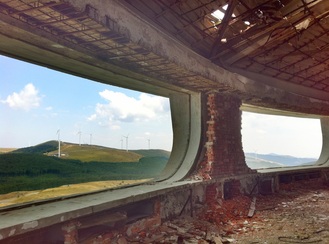 Through old windows, new wind turbines... But is Buzludja only a symbol of the party? Or is it also a symbol of the millions of hours of work that went into constructing it by the Bulgarian people? Isn’t it the inheritance of every Bulgarian citizen to remember not only the pain of their people during this time, but also their spectacular workmanship? It is clear that there is interest. While we visited the site, a steady stream of Bulgarians and foreigners visited, though most were not able to enter the way that we did. Perhaps in some way Buzludja as a ruin presents more allure than it ever could have as a shiny tourist attraction. Perhaps it is the very degradation of the place that serves as such a powerful symbol. Rumors are circulating that the Socialist Party might try to renovate the building if the funds can be raised. It would be an auspicious task to undertake given Buzludja’s current condition, but perhaps it would help to restore a part of the country’s lineage that is being lost even as we speak. To see more pictures of Buzludja taken during our visit, go here: http://flic.kr/s/aHsjBiuiX1
A special thanks goes to Timothy Allen and Darmon Richter, whose previous visits to Buzludja and the blogs they wrote about it helped to inform the history presented here. Check out their wonderful accounts of Buzludja, including Timothy’s visit in the middle of a snowstorm, here: http://humanplanet.com/timothyallen/2012/02/buzludzha-buzludja-bulgaria/ http://bohemian-blog.blogspot.com/2012/04/urban-exploration-communist-party.html The following story will resonate with some of you more than others. Flying out of the London airport a few weeks back, I walked by a store that had the new Kindle Touch for 99 GBP(about $155), less than I remembered seeing advertised on the UK Amazon site. I had been thinking about getting an e-reader for our travels so I decided to just go ahead and buy it without the usual research...a rare act of shopping spontaneity on my part! But that night, once we had internet again, I checked the US Amazon site and found that the Kindle (with some unobtrusive advertisements) could be had for only $99. I immediately had buyer’s remorse and thought that maybe I should just carry the kindle in its packaging until we flew out of Dublin, where another of the same store would let me return it. So I went through the arguments in my head. By having the Kindle now I can test it out without having family ship it from America, which is a pain for them anyway. Also Neda and my mother-in-law Nadia might want one as well and this would give them a chance to look at it without shipping it overseas first. I decided I would just keep the Kindle and not worry about returning it just to save a few dollars. 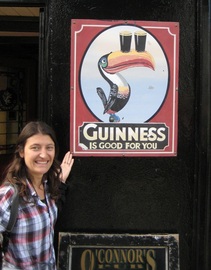 My spiritual mentor ;) But as our trip continued through the UK and Scotland, I still hadn’t opened the Kindle and had brought the question up to Neda several times as to whether I should keep it or not. Even though I had made the decision and reviewed the pros and cons, I was still having trouble letting go of the fact that the Kindle could have been had for about $55 less. Finally, in Galway in Southern Ireland, when I brought it up one more time to Neda, she said something very wise to me. She said, “Sweetie, why don’t you just make that $55 your spiritual practice. Consider it a payment for learning to let go of the other possibilities that are torturing you and to accept what is.” What sage advice from my spiritual partner! It is so important to find those situations in our lives that we have difficulty accepting and practice with them. In this case, the actual situation was as close to meaningless as possible and I was still making myself suffer over it! 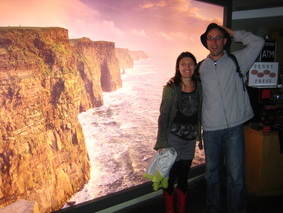 The best view we had of Moher Further opportunities for acceptance were provided throughout Southern Ireland with what is sometimes a traveler’s bane and sometimes an ally: the weather! As we traveled south from Derry to the port city of Galway, the clouds darkened. Our day trip to the Aran Islands was cold with intermittent spitting rain the whole time. The next day we headed to the Cliffs of Moher, where an enduring fog made this our best picture! We only had one day to see this wonder of the natural world, but the weather just didn’t want to cooperate. We could rage against the situation, but nothing would change in the end. Only accepting the situation would release us from the suffering of what could have been. I do understand that there are friends and family in our lives struggling to accept much more difficult situations than paying a bit too much for an electronic device or having bad weather. For them the issue of acceptance is even more difficult, though I think ultimately it is still the only path to relief from suffering. 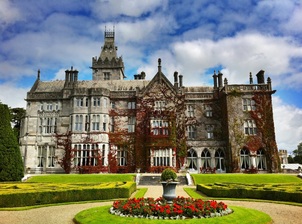 Adare Manor was stunning Luckily, Southern Ireland didn’t continue to test our acceptance of inclement weather. Instead, as we traveled down to Limerick to visit Iain’s friend Irina, the weather took a turn for the better. Irina, a local in Limerick for the past 12 years, generously took us to the best sites the region had to offer. On the first day we hiked through the Gap of Dunloe, enjoyed amazing views of the Ring of Kerry, and had a pint in the tidy town of Killarney. We also visited the beautiful gardens at Muckross House (set within Killarney National Park) and had lunch overlooking a ruined castle. 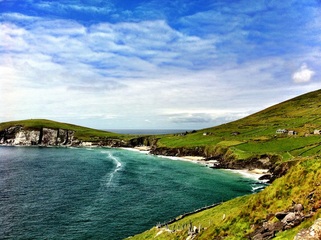 The blaskets on the edge of Dingle The next day we visited the beautiful Dingle peninsula, which has sweeping views of distant isles, hidden beaches, and the friendliest dolphin in history. Fungie, the Dingle dolphin, has lived in the bay of Dingle for nearly 30 years. While most dolphins migrate to warmer waters during the winter, Fungie enjoys the attention of the tourists too much and stays in Dingle the whole year (he is not fed by humans or domesticated in any way). It was a lot of fun to spot him popping out of the water to greet us as we cruised around the harbor. Unfortunately, the company running the tour puts 4-5 boats in the water at once during high season, limiting how much Fungie can do. But Irina’s friend caught this video of Fungie really performing when just one boat was out this past winter. After Dingle, Irina helped us make up for not seeing the Cliffs of Moher by taking us to Ballybunnion, where the local cliffs and rock formations are spectacular and completely non-touristic. We left Southern Ireland for a short stopover in Hahn, Germany, where we visited the cute town of Kastellaun for some Germany beers, a ruined castle and a beautiful hike through the local woods. Now we head back to Bulgaria and wait for our friends Christie & Brett to arrive so we can pay the hospitality forward with a tour of our country! To see the pics of Southern Ireland click here: To see the pics of Kastellaun click here: in memorium
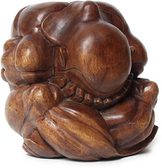 The weeping Buddha is an iconic sculpture in Buddhist art. It is often carved by journeymen wood carvers from a single piece of wood to prove their mastery of the craft. Though there are various explanations as to its meaning, I have always believed that this weeping figure cries for the overwhelming suffering he sees in the world. It has always been a poignant image for me and it was on my mind as we traveled through Northern Ireland. But first things first - we traveled to Northern Ireland via a flight to Dublin. In our one day stopover, Jeff loaded up on passport pages at the US embassy and we spent a pleasant day at the Guinness Storehouse, a museum of Guinness brewing, history, and marketing. We also took a brief course in pouring the “perfect pint” and as luck would have it, some Jehovah’s Witnesses gave us their free beer tickets at the end of the tour…which almost made us miss our bus to Northern Ireland! 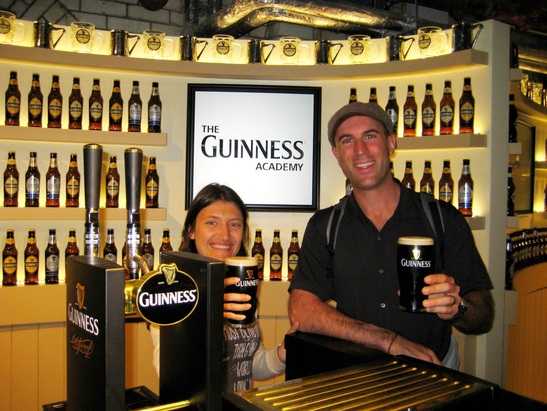
Neda & Jeff learn to pour the perfect pint of Guinness...I learned that a draught of Guinness is infused with 80% nitrogen and 20% carbon dioxide at the tap - which is what gives it the creamy head and flavor. This wasn't invented until the 1950's, however, so before that a Guinness would be much more like a regular stout beer...
In the end some lucky tram timing got us into Londonderry (Derry according to some) on time. Northern Ireland, which is a separate country from the Republic of Ireland and is part of the UK, was a lesson in contrasts for us that can’t be understood without some brief history. It begins in earnest around the early 1600’s. A group of Irish earls fled the country (for reasons still debated) and their estates were quickly confiscated by the Crown. To secure the area for English (and Protestant rule), King James I (VI of Scotland) establishes a plantation scheme whereby the land is to be settled by low-land Scottish raiders living along the English border that he had banished for their crimes. James was tired of the constant border raids of these families and thought that he could solve two problems at once. He could force the migration of the raiders to relieve the troubles along the Scotland-England border while also spreading Protestantism and English rule to the predominantly Catholic population there. The raiders were joined by a plethora of other Scots and some English looking to flee harsh economic times in their countries. 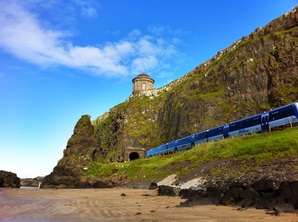 Mussenden Temple near Derry Though the plantation system would eventually repress the native Catholics and lead to the loss of their land, it should be noted that the English Lord in charge of implementing the plantation, Arthur Chichester, thought that an equitable distribution of land to the native Irishmen and incoming Protestants would reconcile the locals to English rule. However, it only took one mishap to tip the scales towards inequality. One of the last remaining Irish earls named Cahir O’Doherty (who was actually an ally of the English in the 9 Years War) was punched in the face by the new governor of Derry George Paulet during an argument. This prompted O’Doherty to seek revenge by burning Derry and starting a rebellion. The rebellion was quashed and with it any chance for equitable distribution. Fearing the local population, King James ensured that Protestants received the lion’s share of the land, sowing dissent permanently into the native Irish population. This was compounded by the exile of all Catholic priests from the area in an attempt to convert the population to Protestantism. It is amazing how one punch can change the course of history. The plantation era in English-Ireland relations was not restricted to Ulster – if you are interested in more of the history you can read about it here. This oppressive situation continued until 1641 when the native Catholics staged another rebellion and brutally attacked the Protestant landowners and their families. This act of violence was met in kind by the enraged Protestants of Ulster and the cycle had begun. The next 400 years would be a continuing battle between protestants and Catholics, culminating in the late 1960’s with the beginning of what they call “The Troubles”. The troubles were a time of increased militant action between paramilitary groups like the Irish Republican Army (which wanted to see a united Ireland with no influence from the British Crown) and the loyalist Ulster Volunteer Force, who wished to defend their right to stay a part of the UK and to be Protestant ruled. After over 30 years of fighting, a truce was made with the Belfast agreement of 1998. Our experience was that while much of the paramilitary activity has subsided in Northern Ireland due to this truce, the tribal division between the two groups of people was still starkly evident. 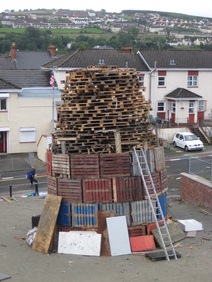 Preparing the bonfire for 11th eve As we traveled through the North, various towns would be coated with either loyalist colors (the red, white, and blue of the United Kingdom Union Jack flag and the Flag of Ulster) or the nationalist colors of the Republic of Ireland (green, white, and orange). Even today, if boys living in a Protestant enclave near the center of Derry wander too far from their homes, they are swiftly given a beating by the Catholics surrounding them. We happened to be in the country on the 12th of July, a holiday where Protestants celebrate the victory of William of Orange over King James II at the Battle of the Boyne. This victory essentially sealed protestant rule over Northern Ireland. The evening of the 11th is marked by an enormous amount of massive bonfires lit by the Protestant population all over the country (we went to 3 alone in a little neighborhood outside Derry). The day of the 12th is then followed by talented marching bands touting the orange colors and Ulster Flag as they march through Catholic and Protestant neighborhoods, celebrating a victory that divided their country 400 years ago and left the native population as 2nd class citizens. 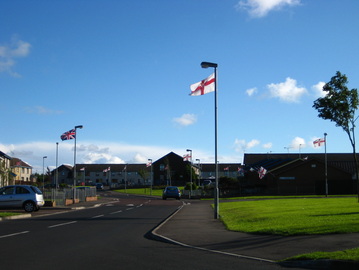 Partisan flags fly in most neighborhoods As I watched this parade, the image of the weeping Buddha was strong in my mind. I could see him crying at the terrible suffering that both sides of this battle had endured. Long ago this conflict stopped being about who is wrong and who is right as the vicious cycle of violence followed by revenge played out over and over. The hardcore Catholics side was unwilling to forget the way their land was occupied and accept that the Protestants are a legitimate part of their country now. The hardcore Protestants were terrified that a Catholic majority will lead to them becoming 2nd class citizens out of revenge. While the Belfast Agreement has led to non-violent power sharing for the last 15 years, the sectarian separation between the people of Northern Ireland has not abated. While all of this conflict and hatred can seem overwhelming, our experience in Northern Ireland was still defined by smiling Buddhas more so than weeping ones. Our friend Iain (who Neda had only met once before we came to see him in Derry) planned a whole 4 day itinerary for us while we were in his country. He and his family graciously invited us to stay in their home as we traveled to the geological wonders of the Giant’s Causeway and the Marble Arch Caves. Iain’s friend Alex took us on a wonderful tour of the city walls of Derry, fielded all my questions about the history of the region, and even served us a delicious high tea. Random folks at the pubs bought us pints of Guinness and welcomed us to their country. It was clear that the kindness of human nature was still shining through in Northern Ireland, despite the fog of division that rested over the country. 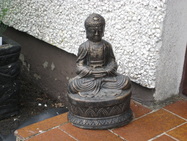 June's Smiling Buddha Nowhere has the contrasts in a country been so evident than during our visit to Northern Ireland. Nowhere have we seen such separation between people and yet nowhwere have we been given so much love. A warm thank you goes to June and John, Iain’s parents, who cooked wonderful meals for us, took us on hikes in the area, and shared their stories with us. See the wonderful pics of the sunny days we had at Giant’s Causeway, Mussenden temple, Carrick-a-Rede rope bridge and more here: http://flic.kr/s/aHsjAF5GrA
|